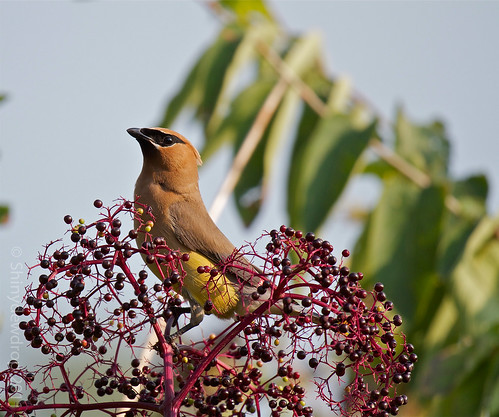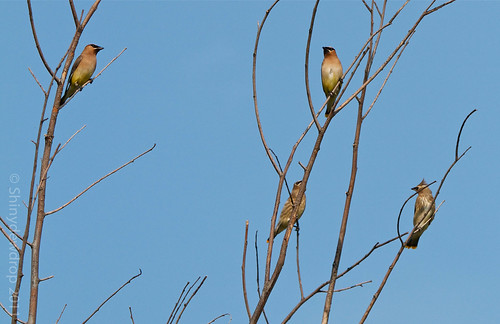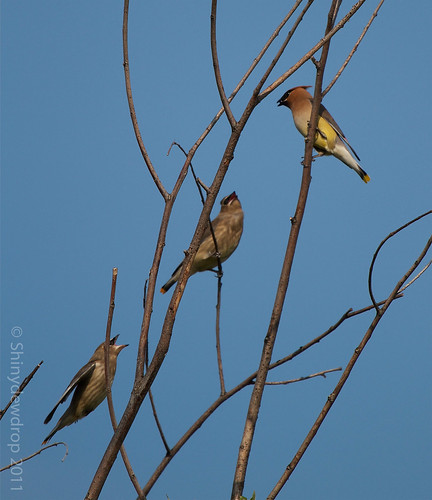I had just started becoming interested in birding, and these birds fascinated me to no end. I had been fascinated by the acrobatics I saw them do when trying to pluck berries off the trees and knew that I would want to spend some more time watching them. I saw them very briefly that time, and despite my returning to that area time and again after that in the hopes of catching another glimpse, I never did.
A few months ago, my friend Swati told me that she saw a large flock of birds in a nearby tree and when she sent me a picture of the birds, I jumped right off my chair - they were Bohemian Waxwings (if I remember correctly) and I was so excited! But then I remembered that she was in San Francisco, and I wouldn't be privy to this sight at all! So, I guessed I'd have to somehow find these birds here, in my neck of the woods. And so I did! :)
I saw Waxwings for the first time this season on my trip to Charlevoix. I went out very early a couple of mornings to catch the sights and sounds of the area, and could't believe my eyes when I saw a flock of about 5 - 6 Cedar Waxwings eating berries. Since then, I have seen them on a couple more occasions, and I also had the great opportunity of seeing them feeding their babies!
The next few images of feeding their young aren't of good quality at all, and are severely cropped to get any detail since the birds were really high up in a far away tree. I wanted to post them anyway, since I observed a pattern in their feeding habits. The parent never feeds the entire berry to the baby in one shot. They keep placing it in the baby's mouth, taking it out, and then putting it back again. They do this a few times, until they put the entire berry into the baby's mouth. I have to assume that the baby probably sucks the juices out of the berry first until it shrivels up and becomes small enough to swallow. No idea!
As you've most likely guessed, there are actually two species of Waxwings - Cedar, and Bohemian. Cedar Waxwings are more colourful with a brown head, light gray wings and a lemon yellow belly, whereas, the Bohemian Waxwings are mostly gray with a rusty undertail. I'm yet to see a Bohemian Waxwing, as they're more common in the West. The Cedar Waxwings also have distinctive red spots on the tips of their wings, and bright yellow at the tips of their tails.
The following image is of a juvenile. Notice the yellow tail tips.
This looked like a family to me - the parents and the two young ones
The most distinctive feature of either species of Waxwings, is perhaps the black mask around the eyes, and a drooping crest. They have a high-pitched trill and I have mostly seen them eating berries and feeding the berries to their young.
I believe they also eat insects, but I've missed the action. I don't remember seeing this bird go after the bee, although it was clearly observing it. I got a few shots of it calmly watching the bug.
I went back to the forest where I found them last time in the hopes of being able to get some good shots of the feeding, but normally, they are so high up in the trees, or so far away, it's very difficult to get access to them.
One of the places I saw them was at Bois de Liesse in L'Ile Bizard, about a 45 min. drive from Montreal. Beautiful park, and the boardwalk that leads visitors into the marsh lands is a place that every birder must walk down to see the many different bird species that make their home there during the summer.















Great shots. Never saw those in my area.
ReplyDeletethequietone.net
Thanks a lot, Cathy! One of my favourite bird species, besides the warblers and the cardinal.
ReplyDeleteAbsolutely fantastic. Please post them on FB too so that your FB friends can take a look too .
ReplyDeleteThanks a lot, Swati! :)
ReplyDelete